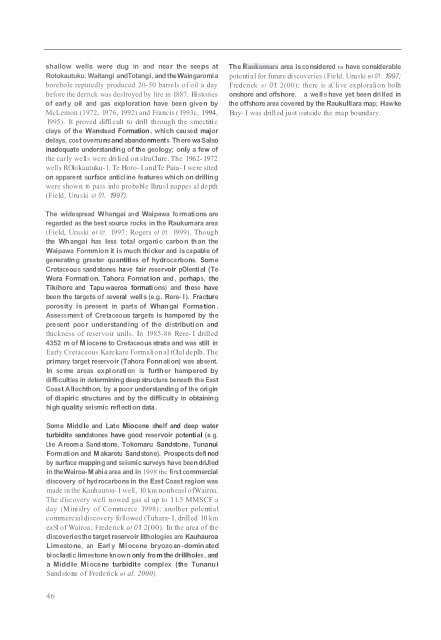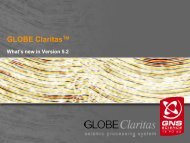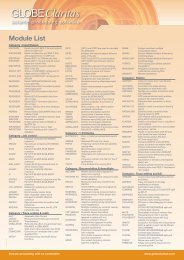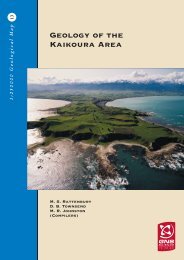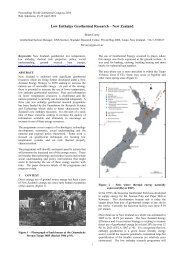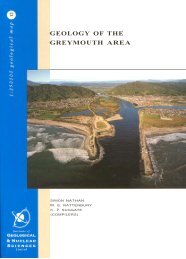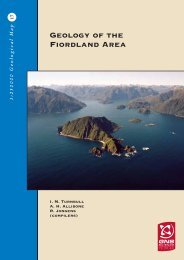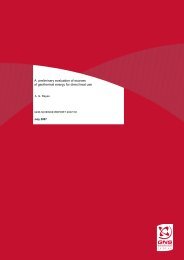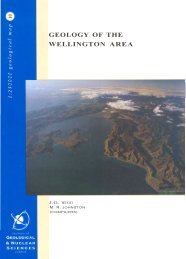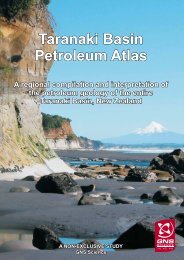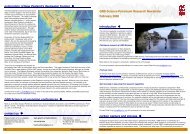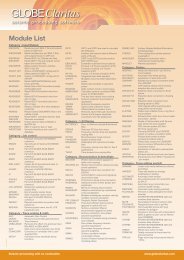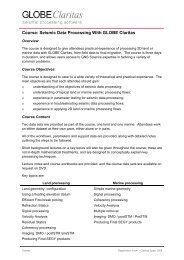GEOLOGY OF THE - GNS Science
GEOLOGY OF THE - GNS Science
GEOLOGY OF THE - GNS Science
You also want an ePaper? Increase the reach of your titles
YUMPU automatically turns print PDFs into web optimized ePapers that Google loves.
shallow wells were dug in and near the seeps atRotokautuku. Waitangi andTotangi, and theWaingaromiaborehole reputedly produced 20-50 barrels of o il a daybefore the derrick was deslroyed by lire in 1887. Historiesof earl y oil and gas exploration have been given byMcLemon (1972, 1976, 1992) and Francis ( 1993c, 1994,1995). It proved difficult to drill through the smectiticclays of the Wanstead Formation, which cau sed majordelays, cost overrunsand abandonment s. There waSalsoinadequate understanding of the geology; only a few ofthe early wells were dri lied on slruClure. The 1962- 1972wells ROlokautuku- 1. Te Horo- I andTe Puia- I were sitedon apparent surface anticl ine features which on drillingwere shown 10 pass inlo probable Ihrusl nappes al depth(Field, Uruski el 01. 1997).The Raukullmra area is considered to have considerablepotential for future discoveries (Field. Uruski el 01. 1997;Frederick el 01. 2(00); there is aC li ve exploralion bolhonshore and offshore. a wells have yet been dri lled inthe offshore area covered by the Raukulllara map; HawkeBay- I was drilled just outside the map boundary.The widespread Whangai and Waipawa fo rmations areregarded as the best source rocks in the Raukumara area(Field, Uruski el 01. 1997; Rogers el 01. 1999). Thoughthe Whangai has less total organi c carbon than theWaipawa Formmion it is much thicker and is capable ofgenerating greater quantities of hydrocarbons. SomeCretaceous sandstones have fair reservoir pOlential (TeWera Formati on, Tahora Format ion and , perhaps, theTikihore and Tapu waeroa formati ons) and these havebeen the targets of several wells (e.g. Rere- I ). Fractureporosity is present in parts of Whangai Forma tion .Assessment of Cretaceous targets is hampered by thepresent poor understand ing of the distribution andthickness of reservoir unils. In 1985-86 Rere- I drilled4352 m of M iocene to Cretaceous strata and was still inEarly Cretaceous Karekare Formalion al tOlal deplh .Theprimary target reservoir (Tahora Fonnation) was absent.In so me areas expl orati on is furth er hampered bydifficulties in determining deepstructure beneath the EastCoast Allochthon, by a poor understanding of the originof diapiric structures and by the difficulty in obtaininghigh quality seismic refl ection data.Some Middle and Late Miocene shelf and deep waterturbidite sandstones have good reservoir potential (e.g.Lhe Areoma Sandstone, Tokomaru Sandstone, TunanuiFormation and M akaretu Sandstone). Prospectsdefi nedby surface mappingand seismic surveys have been driJledin theWairoa-M ahiaarea and in 1998 the fi rst commercialdiscovery of hydrocarbons in the East Coast region wasmade in the Kauhauroa- I well, 10 km nonheasl ofWairoa.The discovery well nowed gas al up to I 1.5 MMSCF aday (Minislry of Commerce 1998); anolher polentialcommercial discovery followed (Tuhara- I, drilled 10 kmeaSI of Wairoa; Frederick el 01. 2(00). In the area of thediscoveriesthe target reservoir lithologies are KauhauroaLimestone, an Earl y Miocene bryozo an-domin atedbioclastic limestone known only fro m the drillholes, anda Middle Miocene turbidite complex (the Tunanu iSandstone of Frederick el al. 2000).46


